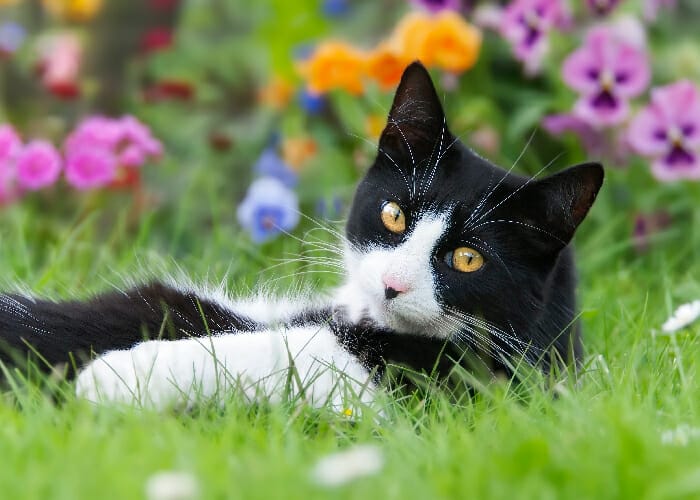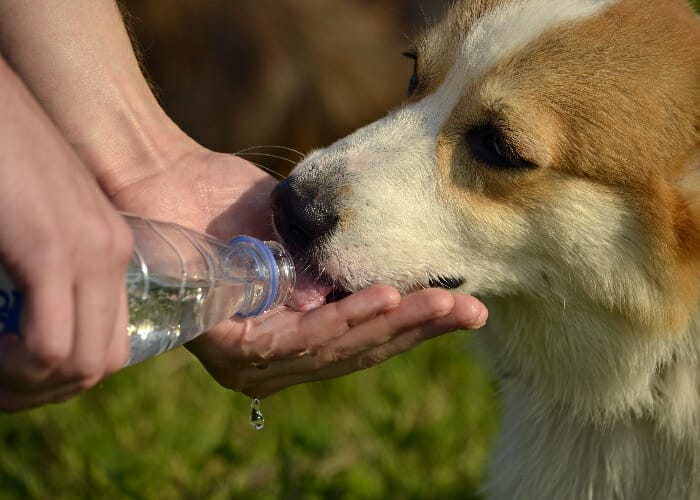Emergency Medicine, Urgent Care
Keep Your Pet Out of the ER With These Spring Pet Safety Tips

Spring is a wonderful time of year. We get longer days, warmer weather, and blooming flowers. However, spring also presents various health hazards that can lead to problems for pets. Whether you are decorating for the holidays or sprucing up your lawn, these spring pet safety tips can help keep your pet out of the emergency room.
Celebrate Spring Holidays with Care
- Lilies are one of the most popular flowers at this time of year but are also one of the most dangerous. Lilies are highly toxic to cats and can cause kidney failure in as little as 24 hours. If you have a feline friend (or friends) at home, consider alternatives such as daisies or orchids.
- If you’re cooking a holiday meal, it’s best not to share your plate with your pets. Human table food such as fatty meats and poultry skin can cause pancreatitis. Ham or turkey bones can splinter and become lodged in your pet or puncture their digestive tract. Certain foods can also be toxic to your pet, including bread dough, grapes, avocado, macadamia nuts, onions, and alcohol. Instead, provide them with their own pet-friendly treats!
- Along with not sharing your plate, try not to leave your table unattended and/or keep food containers covered until it’s time to eat. Minding the garbage is also a good idea to ensure the can does not overflow or get knocked over.
- Does your holiday celebration include candy or chocolate? Take care to hide baskets and treats in places your pet can’t access and keep an eye out for wrappers. Chocolate is extremely dangerous to pets if ingested, as are sugar-free candies made with xylitol. Additionally, any small, wrapped candy can be a danger if your pet ingests it. The candy or wrapper can cause an obstruction.
- Decorative grass, plastic eggs, breakable decorations, gift wrap, and bows can be dangerous as well, so keep these items out of reach. If swallowed, these items can become lodged in a pet’s intestinal tract, which can cause vomiting, diarrhea, and, in some cases, intestinal blockages that call for surgical removal.
Love Your Lawn AND Your Pet by Choosing Plants and Products Carefully
- Read labels and store products with care. Fertilizers are typically fairly safe for pets when spread in the yard but ingesting large amounts can be dangerous so ensure lawn and garden products are stored where pets cannot access them, such as in a cabinet or high shelf. Additionally, some products do contain ingredients that make them tastier (and more dangerous) such as blood meal, bone meal, and feather meal. Be sure to read labels so you know what you are spreading on your yard.
- Mind your mulch. Certain types of mulch can be dangerous. Cocoa bean mulch is one example. It is made of discarded cocoa bean shells or hulls and has a slight aroma that can be very attractive to pets. These products may contain various levels of theobromine and caffeine which are what make chocolate toxic for pets. In addition to the ingredients in the product, ingesting mulch can cause obstructions in your pet that could result in surgery. You can explore alternative options such as rubber mulch or stones. It is best to talk to your veterinarian about products that are safest for your situation.
- Build a fence around your compost area or bin. While compost creates rich soil for your plants, it can create health issues for your pets. As organic matter breaks down, it is common for mold to grow, and some mold can produce hazardous toxins called tremorgenic mycotoxins that can cause tremors or seizures if ingested. Additionally, if you’ve added any toxic foods (like grapes or onion) or plants (like lilies or azaleas) to the pile, those can remain dangerous throughout the decomposition process.
- Be picky about your plants. Lilies, daffodils, azaleas, crocuses, and sago palm are extremely dangerous to pets. And other plants have varying levels of risk. Before planting, it’s best to research what you’ll be growing to keep your pet safe. You can also read more about Toxic Plants, here.

Use Pesticides, Insecticides, and Other Pest Control Products with Caution
- Be sure to read labels and carefully following directions for appropriate application. It is also best to keep your pet out of the area during treatment, even when product directions are marked “safe”. Your pet uses their nose to explore and so they could encounter treatments that are still wet. Using pest control products inside? Ensure all sprays are dried and rooms are well ventilated before allowing a pet back into the area. You may also want to remove pet food bowls, bedding, and toys during treatments.
- For birds, fish, and other exotic pets, it’s generally advisable to take extra precautions during treatments. Covering tanks and cages could be enough, but depending on the treatment, it may be best to remove them from the area. Speak with your veterinarian before you complete any treatments to be sure.
- If you are using baits or traps for rodents or insects, be sure to place them in areas your pet cannot reach. Slug and snail baits can come in powders, granules, pellets, or liquid formulations, and one of the main ingredients is usually metaldehyde, which is toxic to all species. Likewise, bait for moles and gophers can contain dangerous ingredients like zinc phosphide or bromethalin which have no antidote and can result in life-threatening situations.
Ward off Infectious Diseases and Viruses by Taking Preventive Action
- Spending more time outside means you are more likely to meet other animals, so it’s important your pet is up to date on their vaccinations. Viruses like parvovirus are extremely contagious and live in the environment for a long time. Vaccinating your pet is one of the most important things you can do to keep them healthy.
- Fleas, ticks, and mosquitos aren’t just annoying, they can pass along harmful diseases. Make sure you are giving your pet a flea and tick preventative as well as heartworm prevention. As with all medicines, carefully read all labels. Some treatments are for dogs only and can be toxic to cats. You can learn more about flea and tick product toxicity here.
- When outside, don’t let your pet drink from stagnant water or puddles. Leptospirosis is a bacterial infection that can cause severe illness, and the bacteria are spread through the urine of infected wildlife. The bacteria can live in the environment for days when the soil is wet or there is standing water. Always provide fresh water for your pet to drink!

Prevention and Quick Action are Important
These spring pet safety precautions can help keep your pet out of the ER. But we also realize that even with the best efforts, our pets can be curious and get into areas, and things, that aren’t healthy. If you think your pet has been exposed, seek help right away. The sooner you can seek treatment, the better the chances are for your pet’s recovery. Call the Pet Poison Helpline at 855-764-7661, your family veterinarian, or visit your nearest MedVet.